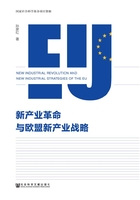
第五节 小结
本章立足于新产业革命的背景,围绕国际金融危机爆发以来欧盟委员会发布的四个产业政策通报,较为深入地剖析了欧盟层面的新产业战略——“再工业化”,包括其出台背景、内容与实施框架以及最新进展,等等。结合前文论述,可以得出有关欧盟“再工业化”战略的几点基本认识。
第一,欧盟提出“再工业化”战略并非一时起意,而是基于过去几十年产业结构调整的经验及相应的认识转变做出的战略决策。“再工业化”的提出标志着欧盟已将工业的地位提升至战略层面,这一转变基于欧盟对新产业革命发展趋势的战略判断,同时也体现了其在国际金融危机后寻求通过结构性手段促进经济复苏与可持续增长的意图。2010年、2012年、2014年和2017年四份产业政策通报的陆续发布,标志着产业政策在欧盟层面受到空前重视,已逐步跻身欧盟经济政策框架的核心位置。
第二,欧盟“再工业化”战略的总体目标是到2020年将制造业增加值占欧盟GDP的比重提升至20%,但是并非简单地基于现有产业结构提高制造业与工业所占比重,而是要抓住新产业革命机遇重构工业与制造业产业链。与第一章总结的新产业革命的核心内容一致,欧盟“再工业化”战略的方向可归结为促进工业的智能化、网络化和绿色化发展,而且特别强调工业绿色化发展的重要性,具有典型的“欧盟特色”。此外,欧盟“再工业化”战略确定的优先发展领域既涵盖了重大前沿技术和关键材料,也包括核心基础设施,体现了欧盟系统性地应对新产业革命挑战的努力。
第三,从正式提出以来,欧盟“再工业化”战略始终将鼓励研发创新置于首要地位。如果说研发创新长期以来被欧盟视为提升产业竞争力与拉动经济增长的关键的话,那么如今更肩负着保证欧盟在新产业革命中抢占先机的重要使命。具体而言,从2012年通报确定六大优先领域,到2014年和2017年通报进一步出台细化措施,欧盟鼓励研发创新的做法也发生了值得关注的变化,由起初的集中支持技术研发逐步向支持技术研发与市场化应用并重乃至更加注重支持研发成果的市场化应用转变,这表明欧盟层面对于创新传导机制的认识正在发生转变。
第四,无论是2012年通报提出的“再工业化”战略,还是2017年通报提出的更新版“再工业化”战略,都将刺激工业投资作为实现战略目标的最重要的传导渠道。2012年通报设计了一套包括“四大支柱”与“六大优先领域”的实施框架,旨在重启国际金融危机冲击后低迷的工业投资并使之与产业结构升级相结合;2017年通报则设计了一套包括“六个维度”和“一个支撑”的更具综合性的实施框架,以促进有助于升级重大基础设施和研发创新的工业投资。
以上给出了新产业革命背景下欧盟的新产业战略——“再工业化”战略的整体框架。为了尽可能使研究落到实处,更加全面深入地把握欧盟“再工业化”战略的推进情况,有必要从更具体的部门视角切入做进一步剖析。鉴于此,后文第三、第四章将选取该战略确定的六大优先领域中的两个——关键使能技术和智能电网做较为细致的研究。
[1] European Commission,“Industrial Policy in an Open and Competitive Environment:Guidelines for a Community Approach”,COM(90)556,Oct.16,1990.由于该通报是在“班格曼报告I”[在欧洲共同体委员会时任副主席马丁·班格曼(Martin Bangemann)的领导下撰写]的基础上形成的,因此也被称为“班格曼通报”。
[2] 参见孙彦红:《欧盟产业政策研究》,北京:社会科学文献出版社,2012,第15~23页。
[3] 参见孙彦红:《欧盟产业政策研究》,北京:社会科学文献出版社,2012,第26~32页。
[4] European Commission,“The European Community’s Industrial Strategy”,COM(81)639,Nov.3,1981.
[5] 虽然1957年签订的《罗马条约》已明确提出要建立共同市场,也即意味着要减少可能扭曲共同市场的政府干预,但是直到1980年代初之前,西欧大部分国家一直很重视政府干预在经济发展中的作用。
[6] Laurens Kuyper,“A Policy for the Competitiveness of European Industry”,in Michael Darmer and Laurens Kuyper(eds.),Industry and the European Union:Analysing Policies for Business,2000,p.29.
[7] Laurens Kuyper,“A Policy for the Competitiveness of European Industry”,in Michael Darmer and Laurens Kuyper(eds.),Industry and the European Union:Analysing Policies for Business,2000,p.29.
[8] Laurens Kuyper,“A Policy for the Competitiveness of European Industry”,in Michael Darmer and Laurens Kuyper(eds.),Industry and the European Union:Analysing Policies for Business,2000,pp.29-30.
[9] European Commission,“Industrial Policy in an Open and Competitive Environment:Guidelines for a Community Approach”,COM(90)556,Oct.16,1990.
[10] 自1997年起,制造业竞争力状况评估被纳入《欧盟竞争力年度报告》之内。
[11] 这些政策通报主要包括:European Commission,“An Industrial Competitiveness Policy for the European Union”,COM(94)319,Sep.14,1994;European Commission,“Action Programme to Strengthen the Competitiveness of European Industry”,COM(95)87,1995;European Commission,“Structural Change and Adjustment in European Manufacturing”,COM(99)465,1999。
[12] European Commission,“Industrial Policy in an Enlarged Europe”,COM(2002)714,2002;European Commission,“Some Key Issues in Europe’s Competitiveness-Towards an Integrated Approach”,COM(2003)704,2003;European Commission,“Fostering Structural Changes:An Industrial Policy for an Enlarged Europe”,COM(2004)274,2004;European Commission,“Implementing the Community Lisbon Programme:A Policy Framework to Strengthen EU Manufacturing-Towards a More Integrated Approach for Industrial Policy”,COM(2005)474,2005.
[13] European Commission,“Mid-term Review of Industrial Policy:A Contribution to the EU’s Growth and Jobs Strategy”,COM(2007)374,2007.
[14] 孙彦红:《欧盟产业政策研究》,北京:社会科学文献出版社,2012,第169~170页。
[15] European Commission,“An Integrated Industrial Policy for the Globalisation Era-Putting Competitiveness and Sustainability at Centre Stage”,COM(2010)614,Brussels,Oct.2010.
[16] European Commission,“A Stronger European Industry for Growth and Economic Recovery”,COM(2012)582 final,Brussels,Oct.2012.
[17] 2005年,欧盟委员会时任副主席、企业与产业委员京特·费尔霍伊根(Günter Verheugen)在一次访谈中提到,“直到上届欧盟委员会仍存在一些轻视工业的倾向,……但是,现在欧盟已认识到这种观念是完全错误的。工业仍然在欧盟经济中发挥着不可替代的作用,远远超出其产值的贡献。工业与服务业之间的密切联系使得忽视工业基础将付出巨大的代价,包括导致劳动力市场乃至社会关系方面的非常严重的后果。”参见Interview with Günter Verheugen,Vice-president and Commissioner for Enterprise and Industry,http://www.euractiv.com/en/innovation/interview-gunter-verheugen-vice-president-commissioner-enterprise-industry/article-143183。
[18] European Commission,“An Integrated Industrial Policy for the Globalisation Era-Putting Competitiveness and Sustainability at Centre Stage”,COM(2010)614,Brussels,Oct.2010.
[19] 1990年代,原欧盟15国的年均经济增长率为2.1%,而同期美国的年均增长率高达3.2%。
[20] 欧盟委员会认为,统一大市场的第一轮扩张效应至1990年代末已基本上释放殆尽,而2008年国际金融危机爆发前欧洲生产能力的快速扩张主要受到所谓“非理性繁荣”的驱动。参见European Commission,Commission Staff Working Document Accompanying the Document “A Stronger European Industry for Growth and Economic Recovery”,SWD(2012)297 final,Brussels,Oct.2012,p.16.
[21] European Commission,“A Stronger European Industry for Growth and Economic Recovery”,COM(2012)582 final,Brussels,Oct.2012,p.1.
[22] European Commission,“Trade,Growth and World Affairs:Trade Policy as a Core Component of the EU’s 2020 Strategy”,COM(2010)612,Brussels,2010.
[23] 欧盟中小企业国际化战略于2011年出台,见European Commission,“Small Business,Big World-A New Partnership to Help SMEs Seize Global Opportunities”,COM(2011)702,Brussels,2011。
[24] 在2014~2020年财政框架下,欧盟将当前所有的研发支持基金都整合至“地平线2020计划”下,包括原有的科技框架计划(FP)、竞争力与创新框架计划(CIP)中与创新相关的活动以及欧洲创新与技术研究所(EIT)的活动等。“地平线2020计划”的详细内容,参见欧盟委员会网站的介绍:http://ec.europa.eu/research/horizon2020/index_en.cfm?pg=h2020。
[25] European Commission & EIB,“EIB Lending Priorities Associated with a Capital Increase”,A Joint European Commission and European Investment Bank Report to the European Council,参见http://www.eib.org/attachments/lending-policy-associated-with-a-capital-increase-final.pdf。
[26] European Commission,“An Action Plan to Improve Access to Finance for SMEs”,COM(2011)870 final,Brussels,Dec.2011.
[27] European Commission,“Towards a Job Rich Recovery”,COM(2012)173 final,Strasburg,April 2012.
[28] European Commission,Commission Staff Working Document Accompanying the Document “A Stronger European Industry for Growth and Economic Recovery”,SWD(2012)297 final,Brussels,Oct.2012,p.16.
[29] European Commission,“A Stronger European Industry for Growth and Economic Recovery”,COM(2012)582 final,Brussels,Oct.2012,p.8.
[30] European Commission,“Preparing for Our Future:Developing a Common Strategy for Key Enabling Technologies in the EU”,COM(2009)512/3,Brussels,2009.
[31] European Commission,“A Stronger European Industry for Growth and Economic Recovery”,COM(2012)582 final,Brussels,Oct.2012,p.9.
[32] European Commission,Commission Staff Working Document Accompanying the Document “A Stronger European Industry for Growth and Economic Recovery”,SWD(2012)297 final,Brussels,Oct.2012,pp.31-32.
[33] European Commission,Commission Staff Working Document Accompanying the Document “Strategy for the Sustainable Competitiveness of the Construction Sector and Its Enterprises”,SWD(2012)236 final,2012,p.2.
[34] European Commission,“Impact Assessment of Energy Efficiency Directive”,SEC(2011)779,June 2011,p.6.
[35] 《欧盟可再生能源条例》(Directive 2009/28/EC)的内容参见欧盟官方网站的介绍:http://eur-lex.europa.eu/LexUriServ/LexUriServ.do?uri=CELEX:32009L0028:EN:NOT。
[36] European Commission,“Smart Grids:from Innovation to Deployment”,COM(2011)202 final,Brussels,April 2011.
[37] 自2011年起,欧洲标准化委员会(CEN)开始在生物燃料与生物产品、可持续的建筑材料、智能电网等领域积极地开展工作。
[38] European Commission,“For a European Industrial Renaissance”,COM(2014)14 final,Brussels,Jan.2014.
[39] 容克委员会上任后提出了十大优先政策日程,除此处列出的经济领域的六项优先日程之外,还包括公正与基本权利、移民、塑造更强大的全球行为体、民主改进(Democratic Change)等其他四项日程。
[40] European Commission,“Investing in a Smart,Innovative and Sustainable Industry:A Renewed EU Industrial Policy Strategy”,COM(2017)479 final,September 2017.
[41] European Commission,“Digitising European Industry:Reaping the Full Benefits of a Digital Single Market”,COM(2016)180 final,Brussels,April 2016.
[42] “欧洲学期”机制是希腊主权债务危机发生后欧盟推出的一项深化和扩大政策协调的重要改革举措,旨在使欧盟层面及时掌握成员国的公共财政状况与推进“欧洲2020战略”的经济改革进展,以便及早发现问题,向各国提出有针对性的指导意见,并对各国政策进行协调。该机制的出台背景与制度设计等内容可参考周茂荣、杨继梅:“‘欧洲学期’机制探析”,《欧洲研究》2012年第3期,第17~27页。
[43] 为了更好地制定和执行欧盟产业政策,自2017年起,欧盟委员会专门发起“欧洲工业日”,以年度论坛的形式召集政策制定者、工业界、工会和其他利益相关团体代表共同讨论欧盟产业政策取得的进展和未来面临的挑战,旨在为政策执行和必要的调整提供参考。论坛每年2月在布鲁塞尔举行。